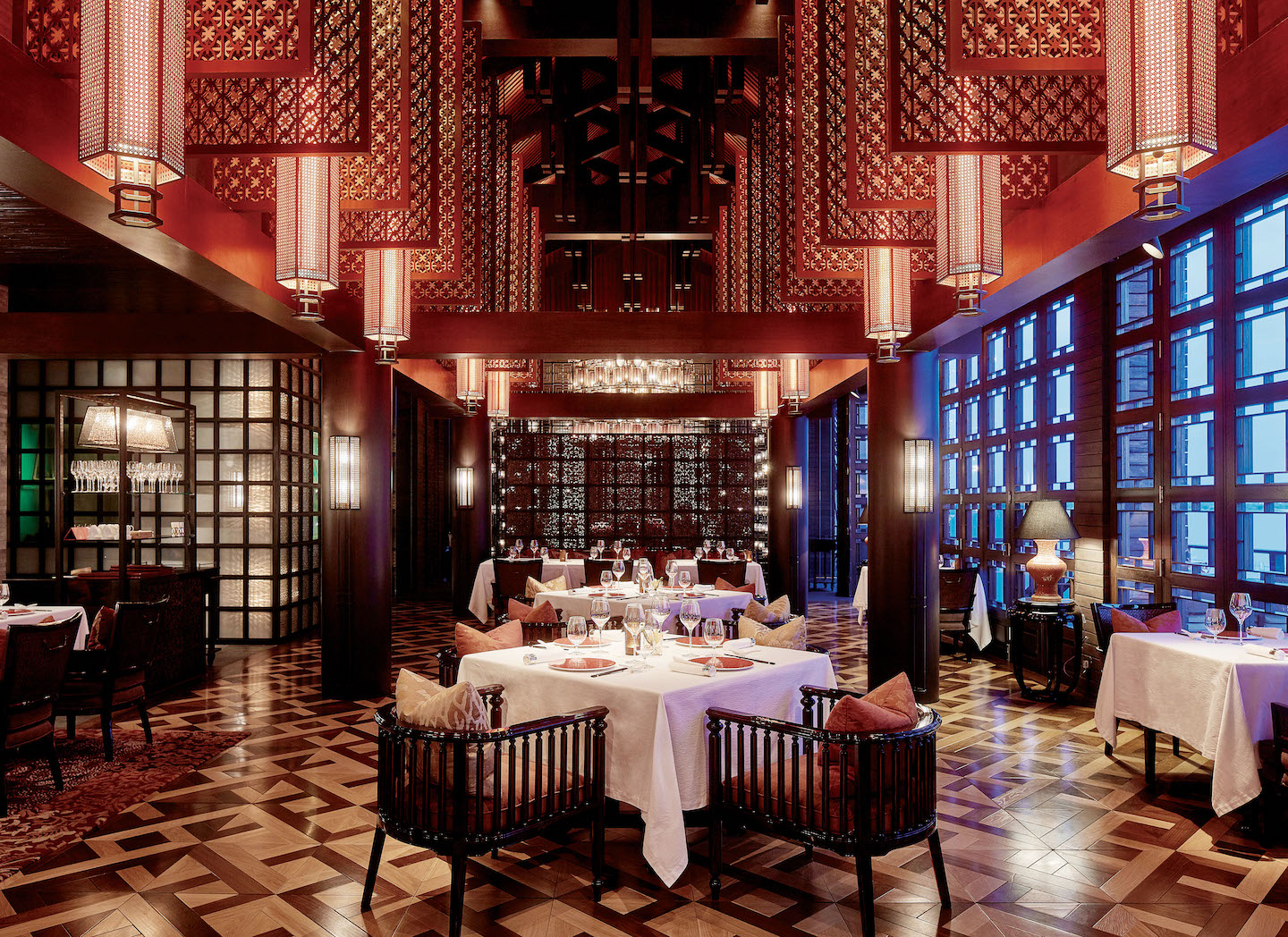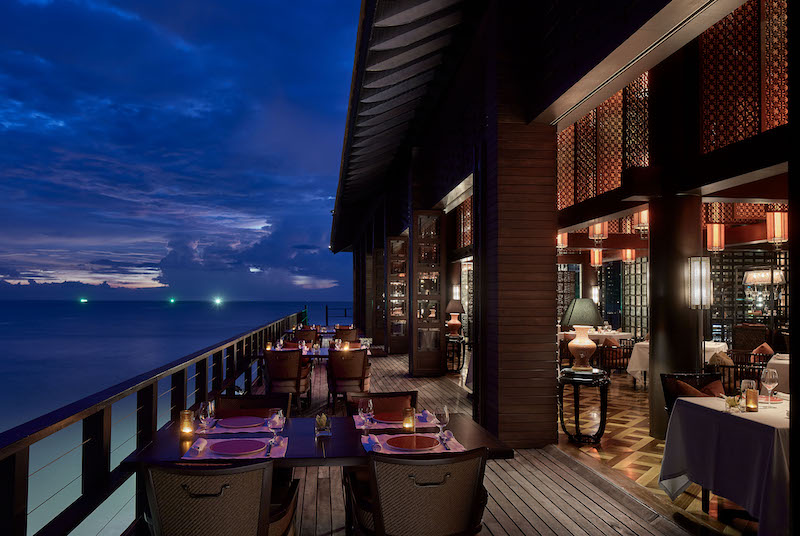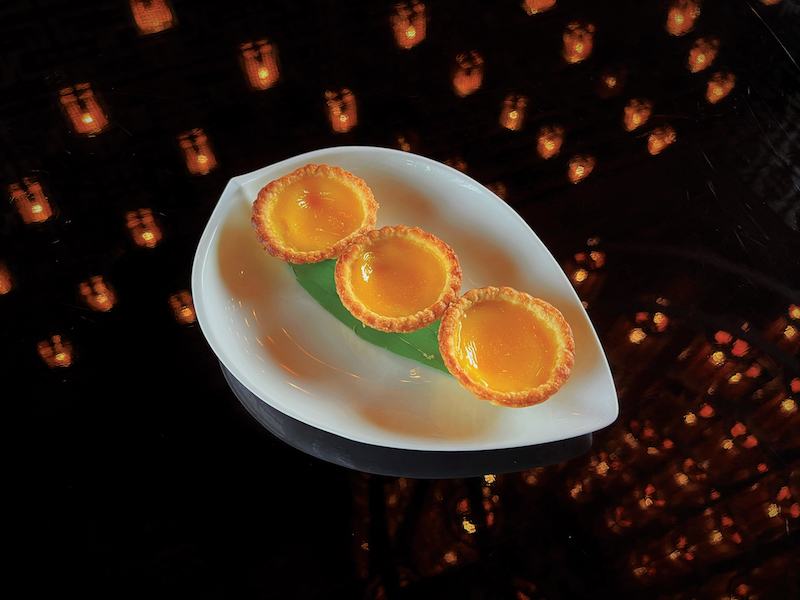
The Ritz-Carlton, Langkawi’s Oriental-inspired eatery Hai Yan reopened after a two-year hiatus (All photos: The Ritz-Carlton, Langkawi)
Reopening after a two-year hiatus, The Ritz-Carlton, Langkawi’s Oriental-inspired eatery Hai Yan is ready to serve up a new menu in a refreshed setting. If you’ve previously been, what may strike you as new is the addition of dim sum for lunch and a few modern takes on traditional Chinese dishes.
Upon entering, a grand chandelier draws the eye — a modern interpretation of Tibetan prayer wheels that are said to bring good luck. Each wheel has an intricately hand-woven bamboo lantern in red with black lines that follow through the entire structure. While there are a few of these chandeliers throughout the restaurant, the biggest boasts an impressive 144 lanterns.
To the left of the entrance is a private dining room that seats up to eight guests. Inspired by the symbolism and abundance of sea cucumber, which is also commonly used in local medicinal oils, this room is named the Gamat Suite. Intimate and beautifully decorated, this suite also has a section with lounge chairs and, of course, a view of the sea.
To the right of the entrance is the main dining space. Aptly named “treasures of the sea”, Hai Yan has a spectacular view of the surrounding waters and seating is also available on the deck. “As much as the hotel would like to get the rooms ready, there’s always a space and time for the guests to have lunch first and then go to the room. Since Horizon and Beach Grill are mostly al fresco, and Langkawi Kitchen is closed for lunch, we wanted to give guests another dining option in an air-conditioned venue,” says general manager Ellen Franke. Having an indoor space to take refuge in especially on hot Langkawi afternoons is certainly a boon.
rc_langkawi2_day2-348.jpg

From the wood floors and windows to the intricately carved wood panels that decorate the ceiling, Hai Yan’s pattern on pattern aesthetic seamlessly melds tradition and modern. On our first visit, daylight brightened the space, which is mostly made up of dark furniture and deep reds. “Even the colour of the wood on the ceiling and the reds used are not the pure very bright Chinese red. It is a little bit more warm, bordeaux-ish. The décor is a modern twist on a Chinese restaurant in a resort,” adds Franke.
Before the refurbishment, the Chinese restaurant only served dinner and the menu was filled with expensive seafood that did not exactly entice locals. “We wanted to attract more people … So we tried to relook it by going through a proper market research process,” says executive chef Mattia Salussoglia. The rigorous research found that serving dim sum would be the perfect addition.
Salussoglia’s Hai Yan team is made up of three Js — executive sous chef Jay Goh, dim sum chef Chang Jia Kit (known as J.Jay), and assistant restaurant manager, Jerry or JJ. “Chinese cuisine often operates in terms of specialities, like if chef Dan is working the fry station, he just does only that. The cutter chef will only cut. But here, we are fortunate enough to find people who also want to learn other things,” says Salussoglia, adding that the three J’s work collaboratively, and are eager to explore outside of their individual disciplines.
To give us a small taste of the efforts that go behind our favourite dim sum dishes, J.Jay took us through a mini xiao long bao-making class. As fun and educational as the session was, very few “perfect” xiao long baos made the cut. One definitely has a higher appreciation for this art form after the class.
lunch.jpg

Finally we sat down for a dim sum lunch in the main dining area. Sinking into the low and deep seats with plush red and gold cushions — these were purposely chosen so guests would feel comfortable — we perused the gold menu cards decorated with a red tassel. To start were four types of steamed dim sum: a traditional chicken siew mai with prawn; a delicious har gow or prawn dumpling with water chestnut; a pillowy soft chicken char siew pau; and a pink skin vegetable dumpling with truffle that had a satisfying bite. These were served with the in-house shrimp paste, which really gave some of the dim sum that added layer of flavour. These artfully created dumplings were followed by the steamed xiao long baos made at our class, and while they were tasty, our inexperience definitely showed as the skin was thick and there was a distinct lack of uniformity in size.
The fried dim sum — some would argue it’s the best kind of dim sum — included five standout creations. The first two were visual illusions that had a modern twist on traditional flavours. The mushroom bun was made to look exactly like a mushroom cap by dusting cocoa powder on the skin before steaming to create the organic cracked lines. Its soft skin was a great textural balance with the earthy mushroom filling. What looked like a fried carrot was actually a chicken dumpling with a chewy glutinous rice flour skin and an asparagus in place of its green stem.
The fried beancurd skin roll with shrimp and water chestnut had a familiar and comforting flavour. The freshly baked egg custard tart was a work of art, as it had a thousand-layer shell that was delicate and flaky, brought together with the creamy custard at the centre. It was divine. The same thousand layer pastry was employed for the baked honey barbecued chicken puff, which gave every bit of this savoury and sweet filling an incredible texture.
freshly_baked_egg_custard_tarts.jpg

Hai Yan also makes its noodles in house, so the following dish was definitely a treat. The dan dan noodles were perfectly al dente with a lightly spiced peanut sauce that was simple, yet addictive.
For a sweet ending, we were served chilled mango pancake which was given an added depth of flavour with a drizzle of tualang honey, and a pudding with beautifully defined passionfruit and milk layers whose rich creaminess was cut by the tangy fresh passionfruit on top. Why have one dessert when you can have two, right?
Sunset supper
But it is at night when Hai Yan is truly transformed. The chandeliers come alive and the dark lacquered furniture as well as the deep red accents make for a more romantic setting. We were told that sunset can be quite a beautiful experience at Hai Yan as well.
For the evening, we made our way to the other private room, the Empurau Suite, named after an extravagant fish that is the restaurant’s speciality. Able to seat up to 10 guests, unlike the Gamat Suite, this room has more windows that open to the sea, which makes it feel extra spacious and luxe.
To showcase the true range at Hai Yan, the menu for the evening included 11 dishes, and thankfully some were sharing plates. The appetisers were braised duck breast with signature Hai Yan buns, which were a sweet bite but balanced with pickled onion; the addictive work-fried Andaman Sea squid with salted egg yolk; and the snack-worthy fried fish skin with curry leaf and chilli. The hot and sour soup was a homey concoction filled with fresh lobster, mushroom, fish maw, bamboo shoots and egg white. Well balanced, this soup had enough spice for it to linger on your lips.
dinner.jpg

The Hai Yan roasted duck wrapped in a delicate pancake with sauces and vegetables was flavoured to perfection. This was followed by the two-way lobster — one was a fragrant fried lobster head with ginger and scallion, and the other, a pan-fried tail with a delicious XO sauce. Other sumptuous wok-fried sharing dishes were the succulent black Angus beef cubes with basil leaf, shallots and garlic; fresh locally farmed vegetables with garlic; and tender eggplant with minced chicken and salted fish.
Again, to sample Hai Yan’s prowess in making noodles, we had the braised e-fu noodles in a seafood and vegetable broth. Filled with scallops, prawns and mushrooms, this dish had the freshness of the sea with a satisfying bite of the fried noodles.
As with lunch, we indulged in two sweet dishes for our final course. The pre-dessert was a refreshing chilled mango cream with sago and piquant pomelo and grapefruit. The main dessert was truly unforgettable. The Hai Yan caramelised egg tart — with the same flaky thousand layer shell — was served with an XO cognac vanilla espuma. While the caramelised sugar on the custard gave a nice bite to the dish, the punch of cognac in the bubbly espuma was a really fun flavour combination.
Like its design aesthetic, Hai Yan’s menu brings together the traditional and contemporary, creating an experience that is only made more unique by the luxurious and relaxing setting of The Ritz-Carlton, Langkawi. The delicious menu and incredible view of the sea certainly demand another visit, very soon.
This article first appeared on May 9, 2022 in The Edge Malaysia.


